|
PERFORMING ANIMAL WELFARE SOCIETY
|
|
|
|
|
|
 |
 |
 |
 |
 |
 |
 |
 |
 |
 |
 |
 |
 |
 |
During this season of Thanksgiving,
we send our heartfelt thanks to each of you, our PAWS
friends, donors, partners, adoptive parents, volunteers and vendors.
We are eternally grateful to each of you for making our work possible.
Warm wishes for a safe and happy Thanksgiving holiday.
And to our thousands of new friends in the City of Toronto, and throughout Canada, thank you, from the bottom of our hearts, for your letters, emails and phone calls filled with kind words, warm greetings and messages of support for PAWS and for the elephants. We are so grateful.
Ed Stewart
PAWS Management & Staff
The Animals
|
Above: Ben, who arrived at PAWS in 2012, was formerly a resident of a private roadside zoo in North Carolina where he had been living in deplorable conditions. After a lawsuit was filed on behalf of Ben by two concerned citizens, and following more than a year of court battles, a judge finally ruled in Ben's favor. PAWS co-founder Ed Stewart accompanied Ben on his FedEx-donated flight to California - cheerfully dubbed "Bear Force One" by the flight crew.
An Update On Ben
Fall has arrived at ARK 2000, with short, sunny days and crisp, starry nights. Recent November rains promise new green grass, and many of the trees are showing beautiful fall colors. All of the bears seem to love fall weather, and Ben is no exception.
Bears are highly attuned to cues from nature, and both their behavior and biology change with the seasons. During the summer, Ben would nap under a shady tree during the hot part of the day, or take a refreshing swim in his pool. As fall arrives, the bears' appetites increase and they become more active, seeking extra food to put on a layer of fat for the winter. During winter, our bears don't truly hibernate but they do tend to be less active, eat less, and take longer naps inside their cozy dens.
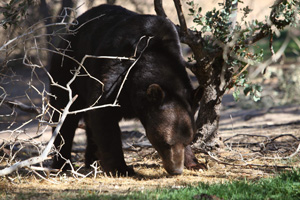 | | Ben, searching for acorns. |
We often see Ben contentedly grazing on green grass in the afternoon. Vegetation is a major part of wild bear diets, and it is wonderful to see Ben enjoying this natural food source that he was deprived of before he came to PAWS. At this time of the year, the oak trees drop their acorns and this is an absolute favorite treat for Ben and the other bears who spend many hours foraging through their spacious habitats for these nutritious treasures. Keepers also hide food treats creatively throughout the habitats on a daily basis, and the bears enjoy finding these hidden surprises.
Ben's physical appearance has transformed since his arrival in the summer of 2012 from deplorable conditions in a North Carolina roadside zoo where he had spent six years living in a 12x22-foot chain-link and cement enclosure. His interaction with others was limited to being gawked at by visitors. His coat has now grown thick and lustrous, and he has developed muscle tone and strength. Years of incessant pacing and stereotypic behavior, caused by cramped confinement and deprivation, have given way to a range of normal bear behaviors which have blossomed since his arrival.
Far too many bears are still held in inadequate conditions throughout the U.S., in need of help. Captive breeding produces a seemingly endless supply of cubs for roadside zoos, photo shoots, the pet trade, and the entertainment industry. Once these cubs are grown, many end up in substandard facilities such as "bear pits" where they suffer from poor nutrition, lack of veterinary care, and sensory deprivation.
Food and general care for one healthy bear costs us approximately $20,000 per year ($385 per week, $55 per day). Please consider making a donation today to help PAWS care for Ben and the seven other bears living at our sanctuaries. Large or small, all donations matter. To become an adoptive parent to Ben, or to give an adoption as a gift, click here for more information. To view more photos of Ben, visit our Facebook page. View our latest Ben video below.
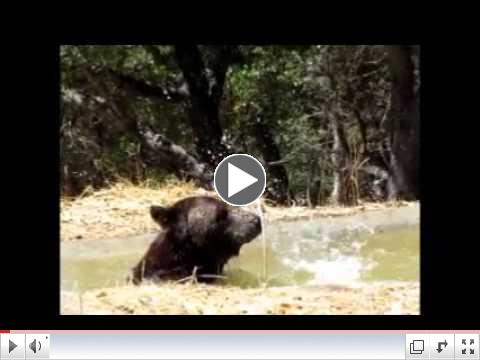 | | Ben the Bear: Splish Splash! |
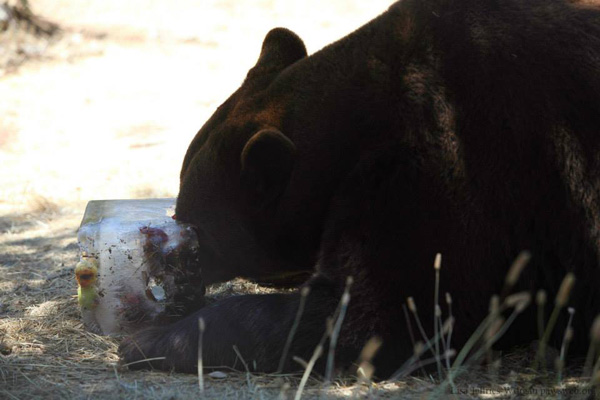 | |
Ben enjoys a fresh fruit ice treat.
|
What Can You Do To Help Bears Like Ben?
Be bear aware! Never patronize a business that allows photos ops and interactions with bear cubs. Once they get larger, these bears will be disposed of by sending them to roadside zoos or to be slaughtered for meat - only to be replaced by more bear cubs.
Avoid roadside zoos with bears and "bear pit" attractions.
Educate family, friends and colleagues about this issue, and urge them to avoid any "attraction" that uses bears for entertainment.
If you live in an area where bears are used for entertainment, write a letter to the editor of your local paper, educating people about the suffering that the bears endure. Bring your concerns to the attention of local elected officials.
|
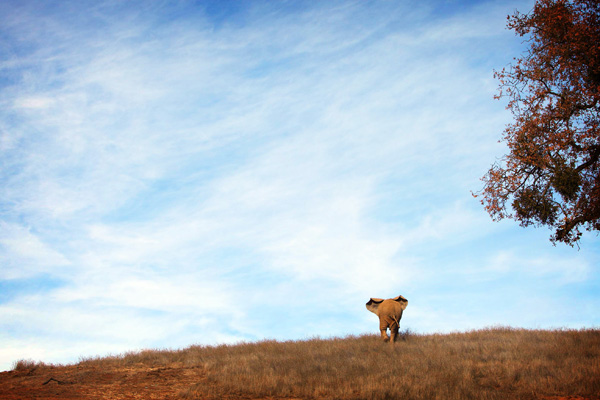 | | Toka takes a walk in the African habitat. |
Toka, Thika & Iringa In Their New Home
It has been just over four weeks since elephants Toka, Thika, and Iringa arrived at ARK 2000 from Toronto, Canada, joining long-time resident elephants Mara, Maggie, and Lulu in PAWS' spacious African elephant refuge. Our dedicated staff is excited to work with these inquisitive new elephants, and have been working around the clock to make them feel welcome in their new home and to ensure their transition is smooth and comfortable.
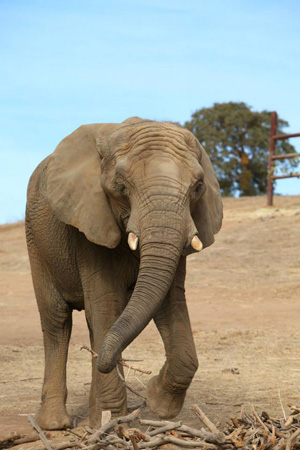 | |
Thika rummages through a stick pile,
a favorite pasttime for all the elephants.
|
Elephants are large, strong, and extremely intelligent, and they live within established, though sometimes shifting, social hierarchies. Elephants also have unique individual life experiences, distinct personalities, and, as long-lived animals, often come to us with pre-existing medical and behavioral issues. Combine all of these factors and you will understand that getting to know a new elephant and integrating her safely into a new group is a slow, deliberate, and careful process. Consideration must be given to previous histories of aggression towards other elephants, and efforts made to mitigate potential compatibility issues.
Our African elephant barn was designed by PAWS co-founders Ed Stewart and Pat Derby to be flexible for just this type of introduction process. Each elephant has her own section of the barn where she can hear, smell, see, and touch adjacent elephants in the barn. There is a central hallway running down the middle of the barn, and 18 hydraulically-operated gates located between each stall and the hallway can be individually opened and closed to allow as much or as little access to each elephant as is appropriate and safe. The outdoor African elephant habitat is similarly designed, with four large separately fenced areas connected by multiple gates that can be opened or closed individually to facilitate introductions.
Toka, Thika, and Iringa are eagerly participating in their own health care, holding still for voluntary blood collection from an ear while being fed favorite treats. Routine medical tests such as blood work and urinalysis are being performed on a regular basis to assess their current health, and also to monitor the status of pre-existing conditions as we treat them. For example, we are addressing longstanding low vitamin E levels in all three elephants by ensuring that they receive adequate vitamin supplementation, and we're checking blood samples periodically to make sure that they are absorbing the supplement. Vitamin E is important for muscle and nerves, and it has antioxidant properties. A deficiency of this very important vitamin can lead to significant health problems. Fresh vegetation is an excellent source of naturally-occurring vitamin E, and we are hopeful that the elephants' overall health will benefit from grazing on grass and browsing on trees and other living plants to their hearts' content.
Toka, Thika, and Iringa are settling in well. Each day, we learn more about them as their individual personalities and preferences gradually emerge. As there is a history of aggression, separation and injury within their group, great care is taken to monitor their time together. We have seen very promising and positive interactions between these three new elephants and our long-time resident elephants Mara, Maggie, and Lulu during the time they've spent inside the barn. PAWS elephant staff members are experienced with introducing elephants, and are fully committed to this sometimes delicate and intricate process. As our co-founder Pat Derby always said, "We are on elephant time" now, observing and patiently encouraging each of our new elephants to proceed at her own pace to find her place within the group.
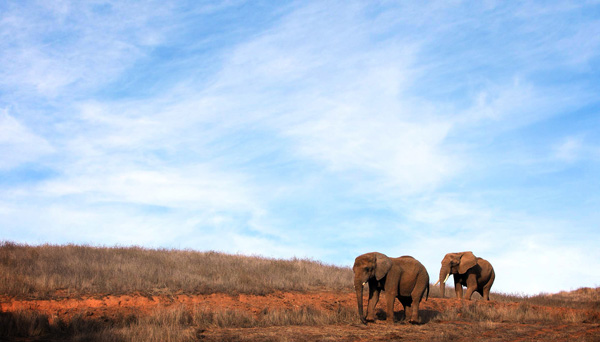 | | Iringa (left) and Toka on the hillside. |
CLICK ON THE PHOTO BELOW
TO VIEW A NEW PHOTO ALBUM FEATURING THE TORONTO ELEPHANTS
(It's a large PDF file, so wait for it to load.)
Look at that sky!
|
 | |
Catherine Doyle
|
Report from the field:
PAWS' elephant behavior study
By Catherine Doyle, PAWS' director of science, research and advocacy
In September, I began a long-term behavioral study involving our African elephants, Mara, Maggie and Lulu. The study is investigating the daily activities of the elephants as well as the elephants' social interactions now and after new elephants Thika, Iringa and Toka are introduced to them. One of the pleasures of conducting this study is observing the elephants' behaviors and how they are affected by seasonal changes and by the different areas of their large habitat they choose to explore.
During my most recent round of observations, the elephants appeared to be enjoying the cooler weather (well, cooler for California: high 60s into the mid 70s), the sanctuary's oak trees (many of which are protected to avoid total destruction), and an abundance of tasty acorns. They spent much of their day foraging in the trees, shaking, pushing, yanking, and tearing off branches for consumption - just as elephants would do in the wild. These behaviors provide a wonderful display of the elephants' great strength and the surprising agility of their trunks.
One of the greatest challenges in conducting this study is finding locations from which I can watch the elephants, as they move throughout the habitat. All I can say is that I'm getting some great exercise, thanks to Mara, Maggie and Lulu! The elephants are always on the move, which means that I'm constantly adjusting my position to be able to record their behaviors. Of course, I am never inside the elephants' habitat - that would be dangerous and it would affect the elephants' behavior. You'll usually spot me on a road or at the top of a high hill, intently observing from a distance, binoculars or iPAD in hand.
Stay tuned for more updates from the field!
|
 | |
Nearly six tons of raw and carved ivory was crushed on November 14.
Photo by Kate Brooks for NBC News.
|
U.S. Sends Message To Crush the Ivory Trade
On November 14, 2013, media from around the world converged outside Denver to witness an historic event: the pulverization of nearly six tons of raw and carved ivory that had been warehoused by the U.S. government for nearly a quarter of a century. The purpose of the event was to bring international attention to illegal wildlife trafficking and the slaughter of an alarming number of African elephants - nearly 100 a day. African elephants are at risk of extinction in as few as ten years unless something is done to curb poaching and a skyrocketing demand for ivory in Asia.
Unfortunately, the sale of ivory within the U.S. remains legal, thanks to loopholes in U.S. ivory trade laws. In fact, the U.S. is the second largest market for ivory in the world. A complete ban on the sale of ivory in the U.S. is long overdue and it would help to set yet another example of how keeping elephants alive and free must be a priority over the trade in ivory.
Read more about the ivory crush and the illegal ivory trade in an interview with Richard Ruggiero, chief of the Africa branch at the U.S. Fish and Wildlife Service, who has worked with elephants and ivory for more than 30 years. More here. . . View the slide show, "On Display: Confiscated Ivory" from NBC News, here. Read this oped in the LA Times regarding how to end ivory poaching and the need for a complete ban on the sale of ivory in the U.S.
|
 | |
Fluffy (pictured) often slept in this relaxed pose.
|
Fluffy, In Memoriam
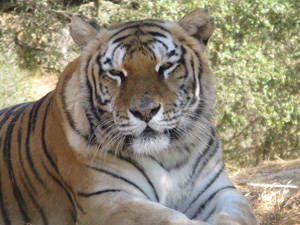 Fluffy was one of 39 tigers that PAWS rescued in 2004 from deplorable conditions at the defunct "Tiger Rescue" pseudo-sanctuary in Colton, California (view video below). PAWS co-founder, Ed Stewart, specially designed and constructed the tigers' new housing at PAWS to preserve and accommodate compatible groups that had formed. Fluffy was one of 39 tigers that PAWS rescued in 2004 from deplorable conditions at the defunct "Tiger Rescue" pseudo-sanctuary in Colton, California (view video below). PAWS co-founder, Ed Stewart, specially designed and constructed the tigers' new housing at PAWS to preserve and accommodate compatible groups that had formed.
During the last 10 years Fluffy lived with a group of tigers that included Couch, a 500 pound male tiger. Fluffy was especially fond of gentle giant Couch, and the two were never far apart.
In the summer of 2012, Fluffy was diagnosed with renal insufficiency during a routine examination. Kidney disease is very common in older big cats, and PAWS' veterinarian, Dr. Jackie Gai, has extensive experience treating this challenging condition in geriatric animals. Fluffy thrived under the special care from her keepers, until late October of this year when her medications no longer provided relief and her appetite and joy for living suddenly declined. Fluffy was euthanized on November 1. A necropsy revealed end-stage, irreversible kidney failure.
Tiger Supervisor Renae Smith remembers Fluffy greeting her keepers every morning with a contented vocalization called a "chuff", and then immediately rolling onto her back to look at them upside-down. She often slept in this supremely relaxed pose, on her back, in her large grassy habitat. We will miss this expressive, beautiful tiger tremendously.
It is never easy to euthanize an animal, and the decision to do so is always made with careful thought and great compassion. We experience a rush of emotions during these times. . . heartbreaking sadness at the loss, but often also a deep sense of frustration at the industry that selfishly breeds wild animals in captivity -- perpetuating the "Cycle of Hell" as PAWS co-founder Pat Derby described it. Both ironic and tragic, wild tigers are critically endangered due to poaching and loss of habitat, while tigers are indiscriminately bred in the U.S. to supply cubs for the entertainment and exotic pet industry - none of whom will ever be released into the wild, and many of whom will live a life of deprivation.
Rest in peace dear Fluffy.
All donations made in memory of Fluffy will be used to care for the rest of the Colton tigers still living at ARK 2000. You can can view their photos here. When the Colton tigers arrived, PAWS assumed the responsibility of giving them lifetime care. We estimate it costs us approximately $18,000 per year ($350 per week, $50 per day) for food and general care for one healthy tiger; veterinary expenses are additional.
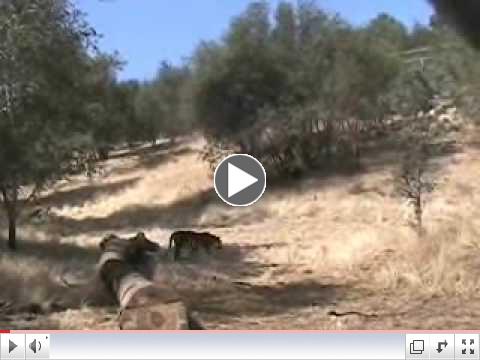 | | COLTON TIGER RESCUE |
|
Good News For Animals:
An End To Elephants In Indian Circuses
The Times of India reported this month that India has stopped the registration of elephants for performances - effectively ending their use in circuses. The decision followed a nine-month long investigation authorized by the Animal Welfare Board of India (AWBI) that documented extensive suffering and rampant violations of Indian laws pertaining to wild animals and to animal welfare. Animal protection organizations PETA India and Animal Rahat conducted the investigation. The AWBI also decided to prohibit the use of old and injured animals in circuses.
|
Speaking of Thanksgiving. . .
Thank You Amazon Wish List Donors
Kelly Fitzgerald: Tree pole saw. Merrill Graham-Armstrong: Scoop shovel for the elephant barns, 1 Exacto knife, 1 5-lb. Psyllium, 1 bottle Renal Essentials, 3 boxes of gloves. Rachel Baron-Pulecio: GoPro Camera for PAWS veterinarian. Janice Chytra: 2 boxes of oranges for the elephants, 1 bottle Milk Thistle, 1 mop bucket for the keepers. Martha Cremer: 2 motor oil, 1 spool trimmer line, 1 package of pillow cases for Ferguson the Macaque, 2 pks AA batteries, 1 bottle Cosequin DS. Rita (no last name): 1 box of oranges for the elephants. Cara McAlister: 1 box of oranges for the elephants. Margaret Muller: 1 box of oranges for the elephants. Jennifer Sukhdeo: 1 5-lb. Psyllium, 1 bottle Milk Thistle. Cynthia Griffiths: 2 orders of peanuts.
Anonymous Donors: 3 boxes of oranges, 1 box gloves, 1 bottle Milk Thistle, 1 Wheat Germ Oil, 1 box trash bags, 1 wire stripper, 1 screwdriver, 1 5-lb. Psyllium, 1 tire pump, 1 spool trimmer line, 1 bottle Cosequin DS, 4 bottles Renal Essentials, 1 order of peanuts.
Special Thanks To Bill Black and Raley's
A very special thank you to Bill Black who stopped at the Raley's store in Elk Grove and talked the manager into donating a pallet of their unsold Halloween pumpkins to PAWS. The pumpkins wouldn't all fit in Bill's truck so he rented a trailer, filled that up as well, and delivered them to PAWS. Thank you Bill and thank you Raley's!.
View wish list items that are needed, but not listed on the Amazon list, here.
|
|
|
|
|
Adopt A PAWS Animal
If you would like to help our animals, one of the best ways is to become an "adoptive parent," or give a PAWS adoption as a gift to an animal lover in your life. PAWS adoptions are symbolic adoptions only. No animal will be sent!
|
PAWS Partnerships
Help us change the life of a victim of captivity by becoming a PAWS Partner.
PAWS partnerships help support our sanctuary operations and the day-to-day care of the animals.
|
You can help us make sure captive wildlife in need of shelter will always have a PAWS sanctuary to call home!
Donate To PAWS
Three ways to give and every donation matters.
Donate Your Vehicle
Learn more
|
|
Lions, Tigers and Bears; 11 Elephants; and a Black Leopard!
ARK 2000 Open House Tickets Are Going Fast!
We have a limited number of tickets available for our ARK 2000 Holiday Open House on Saturday, December 14. If you're planning to attend we advise you to purchase your tickets early. No tickets will be sold at the gate on the day of the event!
Two ways to purchase: Buy online and print your tickets at home; or call 209-745-2606, Monday-Friday, 9 a.m. to 4:30 p.m. PST, to charge by phone. Visit our calendar of events page for more information.
|
|
|
|
 |
 |
 |
 |
 |
 |
 |
 |
 |
 |
 |
 |
 |
 |
|
|
PO Box 849
Galt, CA 95632
(209) 745-2606
|
|
|
|